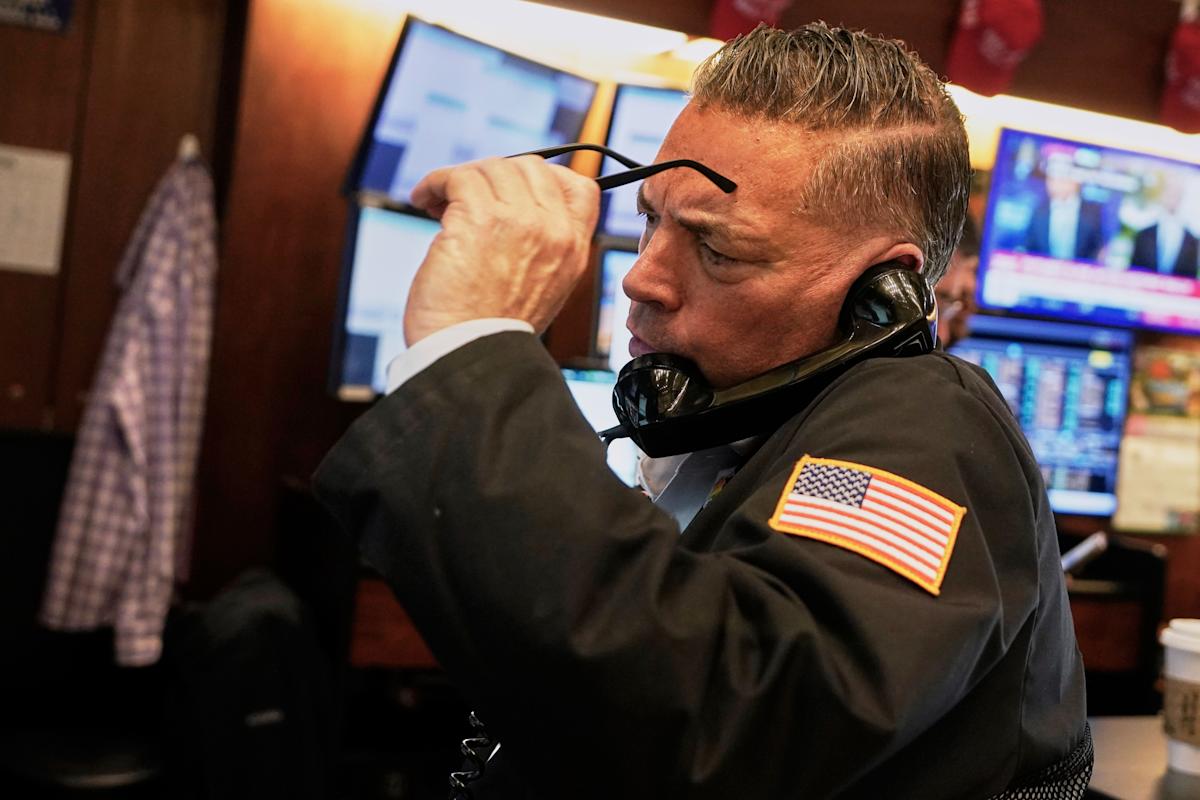US stocks turned higher on Friday to cap a chaotic week on Wall Street, as investors weighed the latest tariff-related developments in the trade war between the US and China.
The S&P 500 (^GSPC) rose 1.8% after seesawing earlier in the session. The tech-heavy Nasdaq Composite (^IXIC) climbed 2.1%. The Dow Jones Industrial Average (^DJI) advanced 1.5%, about 600 points.
Trump’s fast-moving tariff policy has whiplashed stocks this week with historic gains during Wednesday’s session but sharp losses on Thursday.
In the end, the S&P 500 and Dow had their best weeks since 2023, while the Nasdaq’s 7% weekly gain was its best since 2022.
^GSPC ^IXIC ^DJI
Friday’s session caps a chaotic week on Wall Street, with an increased focus on waning appetite for US assets. The benchmark 10-year Treasury yield (^TNX) climbed to its highest level since February, closing around 4.5%. Meanwhile, the dollar (DX=F) index tumbled below the 100 threshold, while gold (GC=F) hit a fresh record.
Consumer sentiment tumbled to its lowest level since 2022 in April as the impacts of President Trump’s tariff policies remained top of mind, with consumers expecting inflation to surge in the year ahead.
China said Friday it will raise duties on imports of US goods to 125%, compared with the 84% previously planned, effective Saturday. The move is in direct response to Trump’s ballooning “reciprocal” tariffs on China, the commerce ministry said, but it also suggested it will “ignore” any retaliatory US hikes in duties.
Read more: Live updates on Trump tariffs fallout
Big Wall Street banks got first quarter earnings season going in earnest on Friday, with results rolling in from JPMorgan (JPM), Wells Fargo (WFC), and BlackRock (BLK). JPMorgan CEO Jamie Dimon said the US economy is going through “extreme turbulence.”
LIVE COVERAGE IS OVER 31 updates
-
Indexes closed up, capping a chaotic trading week as President Trump’s tariff whipsaw sent the major averages on a wild ride.
The S&P 500 (^GSPC) rose 1.8%, notching its best week since 2023.
The Nasdaq Composite (^IXIC) rose 2%, also rising more than 7% on the week to post its biggest weekly gain since 2022, while the Dow Jones Industrial Average (^DJI) advanced 1.5%, or roughly 600 points. The Dow also had its best week since 2023.
Tech (XLK), Industrials (XLI), and Financials (XLF) were the biggest gainers this week, with AI chipmaker Nvidia (NVDA) leading the “Magnificent Seven” group higher over the five-day period.
Gold won the top safe-haven spot on Friday, zooming past a record $3,200 per ounce. A bond market sell-off escalated Friday, with yields on the 10-year Treasury hitting their highest level since February.
-
Tech (XLK), Industrials (XLI), and Financials (XLF) are on track to gain for the past five sessions as Wall Street wraps a volatile week.
The Trump tariff policy took an unexpected turn on Wednesday, prompting historic gains on the major averages after the president announced a 90-day pause on some 75 countries while increasing levies on China to 145%.
On Thursday, stocks fell sharply. But on Friday afternoon, the major averages were firmly in the green.
-
Gold was winning the top safe-haven spot on Friday, zooming past a record $3,200 per ounce, while bonds and the dollar slid.
Gold (GC=F) futures were on track for their best five days since 2020 to cap a chaotic week on Wall Street against the backdrop of an escalating trade war between China and the US.
On Friday, China said it will raise duties on imports of US goods to 125%. The move was in direct response to the Trump administration raising its reciprocal tariffs on China to 145% this week while duties on other countries were paused for 90 days.
COMEX – Delayed Quote • USD“The new highs in gold are signaling a shift in appetite for US assets,” said Ryan McIntyre, senior managing partner at asset manager firm Sprott. “Confidence in the US has clearly been shaken so people are looking to diversify.”
The reaction in the long-dated bond market, typically seen as a safe haven, spooked investors this week as Treasurys have been selling off. On Friday, the 10-year yield (^TNX) surged to its highest level since February to trade at around 4.56%. Bond prices and yields are inversely correlated.
“Usually, gold would need to consolidate at new lows before fresh buyers emerge to take advantage of lower prices … but investors were desperate to find a safe haven amongst the market carnage, particularly after the flight into US Treasuries, the traditional ‘flight to quality’ trade, went so spectacularly wrong,” said David Morrison, senior market analyst at Trade Nation.
-
The Federal Reserve “would absolutely be prepared” to stabilize the market if it were required, Boston Fed president Susan Collins told the Financial Times on Friday.
Collins told the newspaper that “markets are continuing to function well” and that “we’re not seeing liquidity concerns overall.”
However, she said that the central bank policymakers “have tools to address concerns about market functioning or liquidity should they arise.”
“We have had to deploy quite quickly, various tools,” said Collins.“We would absolutely be prepared to do that as needed.”
Investors have been closely watching the market as it wraps up a volatile week.
Yields on the 10-year Treasury spiked to their highest level since February on Friday as the dollar sold off, sparking concerns of decreasing demand for US assets.
-
Yahoo Finance’s Allie Canal reports:
The bond market sell-off escalated Friday to cap off one of the most volatile and unusual trading weeks in recent memory as President Trump’s tariff whipsaw sent yields surging and stocks plummeting.
Long-term Treasury yields ripped higher, with the 10-year yield (^TNX) surging to its highest level since February to trade at around 4.53%, a massive 66 basis point swing from Monday’s low of 3.87%.
According to data compiled by Yahoo Finance, the 10-year has logged its biggest week since November 2021.
Similarly, the 30-year yield (^TYX) jumped 7 basis points to trade near 4.92% — the highest level since January but the biggest weekly surge for the 30-year yield since 1982.
Yields and bonds are inversely correlated, meaning higher yields equal falling bond prices.
-
Yahoo Finance’s Jennifer Schonberger reports:
Read more here.
-
The White House press secretary on Friday said phones are “ringing off the hook” after the US paused tariffs on some 75 countries to give time for them to strike a deal with the US.
The claim follows a trade war escalation with Beijing as the US increased tariffs on China, but paused levies on other countries, while keeping a blanket 10% blanket levy on them.
When asked by a reporter why any US allies would work to isolate China in a trade war, Press Secretary Karoline Levitt replied, “You’ll have to talk to our allies who are reaching out to us. The phone are ringing off of the hooks.”
“They need the United States of America. They need our markets, they need our consumer base,” she said.
-
Nvidia (NVDA) was on track to be the biggest gainer out of the “Magnificent Seven” group following a volatile week on Wall Street.
On Friday, the AI chipmaker rose 2.5%. For the week the megacap was set to gain 17%, thanks to Wednesday’s historic rally after President Trump put a tariff pause on some 75 countries.
Amazon (AMZN), Alphabet (GOOG, GOOGL), and Microsoft (MSFT) were also on track to end the week with gains of around 7% each.
Even Apple (AAPL), caught in the crosshairs of the US-China trade war, was on pace to close out the week by more than 5% higher.
-
US stocks turned green on Friday as investors weighed the latest tariff development in the trade war between the US and China.
The S&P 500 (^GSPC) rose 1.3%. The Nasdaq Composite (^IXIC) rose 1.6%. The Dow Jones Industrial Average (^DJI) advanced 1.2%
The benchmark 10-year Treasury yield (^TNX) pared back gains to hover near 4.47% while the dollar (DX=F) index tumbled below the psychological 100 threshold.
-
The emerging theme from this week’s tariff-sparked whiplash on Wall Street is whether the volatility in US bonds and the dollar signals waning appetite for US assets and their roles as safe-haven assets.
The US Dollar Index (DX-Y.NYB), a key measure of the dollar’s strength against a basket of major currencies, fell below the 100 level to its weakest point since April 2022.
Meanwhile, the 10-year yield (^TNX) surged to its highest level since February to trade at around 4.53%, a massive 66 basis point swing from Monday’s low of 3.87%. When demand for bonds is lower, their yields rise.
The moves this week were sparked by escalating trade tensions between Washington and Beijing, as the US raised tariffs against Chinese goods and China increased levies on American imports.
“Beyond trade frictions, there’s a worrying trend: a decline in the appeal of the dollar and U.S. Treasury bonds as safe-haven assets,” wrote Quasar Elizundia, research strategist at Pepperstone.
“Historically, during times of global uncertainty, these instruments attracted capital seeking safety. However, current dynamics suggest a disconnect. Even amid global turmoil, the sentiment toward the dollar and Treasuries as safe havens is turning negative — a sign that something fundamental may be shifting.”
Perhaps enforcing that sentiment is the rise in gold (GC=F), which surged above $3,200 on Friday to hit a fresh record.
-
The home improvement sector is in flux.
Data from Bank of America shows that home improvement spending declined 2% year over year in March, following an 8% drop in February, underscoring a downward trend affecting the industry.
At the same time, spending on housing-related services grew 6% year over year in March, signaling a shift in how consumers are allocating their home improvement dollars. Analysts at Bank of America noted consumers moved toward contracting professional services rather than buying materials themselves for do-it-yourself (DIY) projects.
The report highlights that 6 out of 10 building categories saw year-over-year gains in March. The strongest performing categories include residential general contractors, roofing, siding, and HVAC services. Meanwhile, floor coverings and concrete contractors saw the weakest demand.
Retailers like Home Depot (HD) echoed this shift, reporting strong sales in appliances and power tools, signaling consumer interest in professional-grade products and services. Still, looming tariffs could throw a wrench into the industry.
While President Trump has reversed some tariff threats, China remains heavily targeted, with Chinese imports facing tariffs of 145%. These elevated duties could significantly raise the cost of building materials and home improvement products, adding more pressure in the months ahead.
-
Yahoo Finance’s Pras Subramanian reports:
Read more here.
-
BlackRock CEO Larry Fink told CNBC on Friday that the US economy could already be in a recession.
“I think we’re very close [to], if not in, a recession now,” Fink told “Squawk on the Street.”
The Trump administration’s tariff policy has sparked fears of a recession. Trump’s 90-day pause on some 75 countries announced earlier this week eased some of those concerns, but the escalating trade war between China and the US has not.
“I think you’re going to see, across the board, just a slowdown until there’s more certainty. And we now have a 90-day pause on the reciprocal tariffs — that means longer, more elevated uncertainty,” Fink said.
-
Another Federal Reserve official poured cold water on the notion of near-term rate cuts due to concerns about the inflationary effects of new tariffs.
Yahoo Finance’s Jennifer Schonberger reports:
-
Long-term Treasury yields ripped higher on Friday, capping off one of the most volatile weeks in the bond market in recent memory.
By mid-morning trade, the 10-year yield (^TNX) surged to its highest level since February to trade at around 4.53%, a massive 66 basis point swing from Monday’s low of 3.87%.
It’s been the biggest week for the 10-year since November 2021.
Similarly, the 30-year yield (^TYX) jumped another 8 basis points to trade near 4.93% — also ahead of Wednesday’s highs.
It’s been the biggest week for the 30-year yield since … get ready for this … June 1982.
-
Stocks flipped into the green after CNN reported that the Trump administration privately reached out to Chinese officials ahead of China’s latest retaliation that raised the country’s tariff rate on US imports to 125%.
SNP – Delayed Quote • USD^GSPC ^DJI ^IXIC
However, China appeared to rebuff that outreach as the US’s global trade provocations have narrowed to primarily focus on the US-China trade war.
From CNN:
-
Consumer sentiment tumbled further in April as the impacts of President Trump’s tariff policies were top of mind.
The latest University of Michigan consumer sentiment survey released Friday showed sentiment hit its lowest level since June 2022. The index slid to a reading of 50.8, below the 57 seen last month and the 53.8 expected by economists.
Pessimism over the inflation outlook soared again in April as one-year inflation expectations jumped to 6.7% from 4.9% the month prior. This marked the highest one-year inflation expectations since 1981. Just three months ago, consumers had only expected inflation of 3.3% over the next year.
Long-run inflation expectations, which track expectations over the next five to 10 years, climbed too, hitting 4.4% in April, up from 4.1% in March.
-
The lone bear on Wall Street coming into 2025 is sticking to his bearish call as tariff uncertainty continues to unsettle markets.
Yahoo Finance’s Brian Sozzi reports:
-
US stocks dropped at the open on Friday after China raised its retaliatory tariffs on US goods, but hinted it won’t respond to any further escalation from the US.
The S&P 500 (^GSPC) fell 0.4%, and the tech-heavy Nasdaq Composite (^IXIC) moved down 0.4%. The Dow Jones Industrial Average (^DJI) was 0.5% lower.
China announced it will increase duties on US imports to 125%, but will “ignore” any further retaliatory hikes from Washington. On Thursday the White House clarified tariffs on Chinese goods stand at 145%. Earlier this week, President Trump paused tariffs on some 75 countries for 90 days.
SNP – Delayed Quote • USD^GSPC ^IXIC ^DJI
-
Oil prices rose slightly on Friday but are on track for their second weekly loss in a row amid a trade war and expectations of more output from OPEC+.
Futures for West Texas Intermediate (CL=F) and Brent (BZ=F), the international benchmark, rose over 0.1%. WTI is trading at the critical $60 per barrel level, while Brent declined to $63 per barrel.
Reuters reports:
Terms and Privacy Policy
Yahoo News – Latest News & Headlines
Read the full article .
Related posts:
- What do Americans think about Trump’s tariffs?
- Roller-coaster week for global bonds continues as ‘Trump put’ sparks reversals
- The losers and winners of Trump’s ‘Liberation Day’ tariff plan
- China’s bond yields are rising — but economists say deflation worries could soon pull them lower
- What the ‘mother of all trade wars’ can teach us about U.S. tariffs, according to economists
- CNBC’s The China Connection newsletter: No deal in sight to stop U.S.-China trade war
- Asian economies scramble to appease Trump as the U.S. president ratchets up tariff threats
- Why the stock market hates tariffs and trade wars
- A global bond sell-off is deepening as investors pare Fed rate-cut expectations
- Trump’s reciprocal tariffs would hit these European Union products that Americans buy the hardest
Subscribe To Our Newsletter
Join our mailing list to receive the latest news and updates from our team.


